

To build this form by the traditional approach without any library, we need to handle the change of input separately. This component will have only one text input in it. Since then, it has been adopted in most of the Google products and is being adopted by many other major companies and websites. Google announced Material design on June 25, 2014. Let’s start with a simple form component. Material Design is a design language developed by Google. If you’re more of a visual learner, check out the accompanying video tutorial: Follow your own design system, or start with Material Design. MUI (formerly Material-UI) is the React UI library you always wanted. The form will also have reset functionality. material-ui VS react-materialize Compare material-ui vs react-materialize and see what are their differences.
#Material ui vs materialize how to#
To show how to use Material UI with React Hook Form, we’re going to build a complete form with the most-used input components provided by Material UI, including: Instead, we’ll focus on the integration between them. We won’t dive too deep into how to use those libraries. To follow along, you should already have some exposure to Material UI and React Hook Form. This tutorial is also helpful if you want to integrate some other React UI library, such as Ant Design or Semantic UI. In this guide, we’ll demonstrate how to use Material UI with React Hook Form. Getting it to work properly can be tricky if you’re using a component library such as Material UI. React Hook Form is one of the most popular libraries for handling form inputs in the React ecosystem. Also, I am a blogger in my free time and love to write about various technical topics.
#Material ui vs materialize software#
Mohammad Faisal Follow I am a full-stack software engineer working with the MERN stack.


 0 kommentar(er)
0 kommentar(er)
